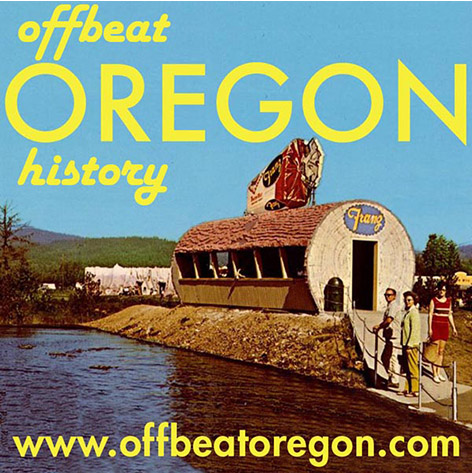FOREST GROVE, WASHINGTON COUNTY; 1910s:
World’s first gas tax made
state a driver’s paradise
Audio version: Download MP3 or use controls below:
|

In 1955, Oregon built its first freeway, again courtesy of the gas tax — a year before President Eisenhower signed the legislation getting America’s interstate freeway system started. That was the Banfield Freeway, in Portland, named after a legendary state highway commissioner and now part of Interstate 84. For all that early work, the interstates took a while to get really popular in Oregon — something you might not believe if you’ve been stuck on I-5 lately. At quitting time on a weekday, anywhere in the Willamette Valley, the freeway is usually bumper-to-bumper. But it wasn’t always like this. In fact, when Bill Bowerman was coaching the University of Oregon track team in the late 1960s, his runners would use the then-newish freeway for practice. They’d run onto the freeway at the north Springfield exit and run to Coburg and back, running in the fast lane going against the flow of traffic — such as there was. On any given day they’d only see a car or two, and they’d see it coming from a long way off, in plenty of time to get into the median to safety. 
Many of the projects the Highway Department has had to spend lots of gas-tax money on are bridges, such as this especially elegant one across the Umpqua River at Reedsport, on Oregon Highway 101. This bridge is, of course, a Conde McCullouch design. The green center arch is made of painted steel, and swings open to allow ships passage. (Image: Postcard)Many longtime residents also remember times, driving between Eugene and Salem for instance, when they were virtually alone, hurtling along, kings of the highway. Some of us (if you reassure us that the statute of limitations has run out) will admit to having actually switched the lights off for a second, just to see what it's like to be hurtling along at 65 miles an hour in the pitch darkness. Well, those days are gone in the valley, although a trip from The Dalles to Pendleton on I-84 can get pretty lonely sometimes. For younger residents, the freeways seem like part of the landscape: always been here, always will be. But Oregon’s freeway system is a relatively young one. Interstate 5 itself was not finished until 1966, just over 50 years ago. Interstate 205, through the east side of the Portland Metro area, is much newer; it was completed in 1982. And the most recent addition to the system, I-82 near Hermiston, was finished in 1988.
And one just can’t bring up the Oregon Highway Department without at least mentioning the time when they used a half ton of dynamite (purchased with gas tax money, of course!) to blow up an eight-ton dead whale that had washed ashore in Florence. From a public-relations perspective, that went even worse than the Nestucca Spit wheeze, although come to think of it the operation did get rid of the whale. (The part that was left over on the beach was small enough to be simply buried in the sand. Oh yes, and here's a link to the Offbeat Oregon article about that, because OF COURSE there is an Offbeat Oregon article about our world-famous Exploding Whale!) But other than these few setbacks, the highway department was something Oregonians were generally supportive and proud of over the years. That’s in spite of the fact that the department raised the gas tax again several more times. By 1952, it was up to 6 cents. And it’s that level of taxation that yielded the glorious motorist’s-paradise highway conditions that Hasso Hering remembers from the old days. Today, the gas tax is 40 cents a gallon, which sounds like a big increase until you adjust that 6 cents for inflation. Six cents in 1952 was worth about 70 cents in modern money. And, of course, the average car’s fuel economy has changed pretty drastically since the 1950s as well, so there’s a lot less cash flowing in per mile driven. So the highway department — which since 1969 has been officially called the Oregon Department of Transportation — no longer has the cash flow to spend promiscuously on big ambitious highway projects like it once did.
|


